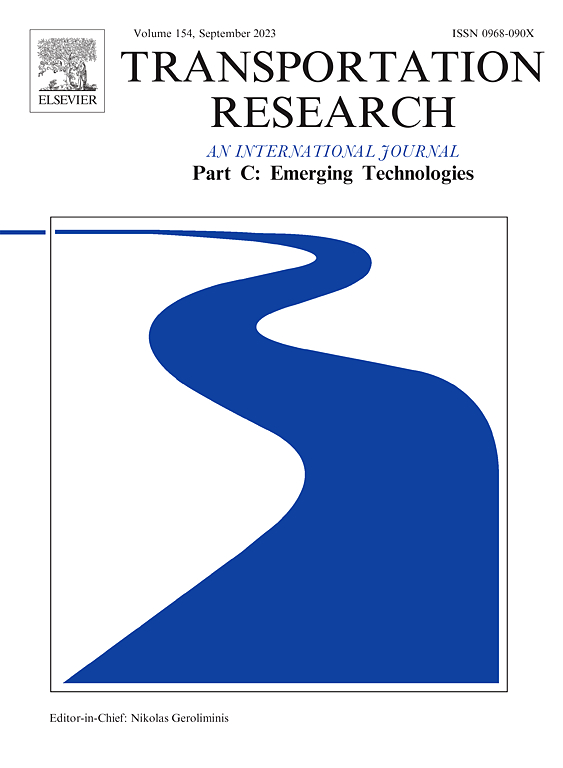互联自动驾驶车辆的无车道交叉路口控制,优先考虑易受伤害的道路使用者
IF 7.6
1区 工程技术
Q1 TRANSPORTATION SCIENCE & TECHNOLOGY
Transportation Research Part C-Emerging Technologies
Pub Date : 2024-11-21
DOI:10.1016/j.trc.2024.104918
引用次数: 0
摘要
随着联网自动驾驶汽车(CAV)的出现,提高道路和交叉路口的通行能力和服务水平有了更多可能性。自动交叉口管理(AIM)和无车道交通就是其中的两个概念。以往关于无车道自动交叉口管理方法的研究很少,而且往往忽略了行人和骑自行车者等易受伤害的道路使用者(VRU)。我们提出了一种新颖的 "先到先得 "无车道 AIM 算法,该算法专为城市环境设计,并给予弱势道路使用者高度优先权。仿真结果表明,我们的无车道方法为 VRU 提供了卓越的服务水平,同时在 CAV 服务水平方面也优于传统的交通信号控制设计和基于车道的 AIM 方法,这意味着部署无车道 AIM 可以改善所有道路使用者的交通流量,同时保持或减少车辆专用的街道空间。我们还研究了引入窄体车辆的影响,发现即使市场渗透率相对较小,我们的无车道方法也能显著提高通行能力。本文章由计算机程序翻译,如有差异,请以英文原文为准。
Lane-free intersection control for connected automated vehicles prioritizing vulnerable road users
With the advent of connected autonomous vehicles (CAVs) come many possibilities for improving the capacity and level of service of roadways and intersections. Two such concepts are automated intersection management (AIM) and lane-free traffic. Previous research on lane-free AIM approaches is scant and often overlooks vulnerable road users (VRUs) such as pedestrians and cyclists. We present a novel first-come, first-served lane-free AIM algorithm specifically designed for urban environments and to give VRUs high priority. Simulation results show that our lane-free approach provides an excellent level of service for VRUs while also outperforming both a conventional traffic signal control design and a lane-based AIM approach with respect to CAV level of service, meaning that the deployment of lane-free AIMs could result in improved traffic flow for all road users while maintaining or reducing the amount of street space needing to be dedicated to vehicles. We also investigate the influence of the introduction of narrow vehicles and find that significant capacity improvements can be achieved with our lane-free approach even for relatively small market penetration rates.
求助全文
通过发布文献求助,成功后即可免费获取论文全文。
去求助
来源期刊
CiteScore
15.80
自引率
12.00%
发文量
332
审稿时长
64 days
期刊介绍:
Transportation Research: Part C (TR_C) is dedicated to showcasing high-quality, scholarly research that delves into the development, applications, and implications of transportation systems and emerging technologies. Our focus lies not solely on individual technologies, but rather on their broader implications for the planning, design, operation, control, maintenance, and rehabilitation of transportation systems, services, and components. In essence, the intellectual core of the journal revolves around the transportation aspect rather than the technology itself. We actively encourage the integration of quantitative methods from diverse fields such as operations research, control systems, complex networks, computer science, and artificial intelligence. Join us in exploring the intersection of transportation systems and emerging technologies to drive innovation and progress in the field.

 求助内容:
求助内容: 应助结果提醒方式:
应助结果提醒方式:


